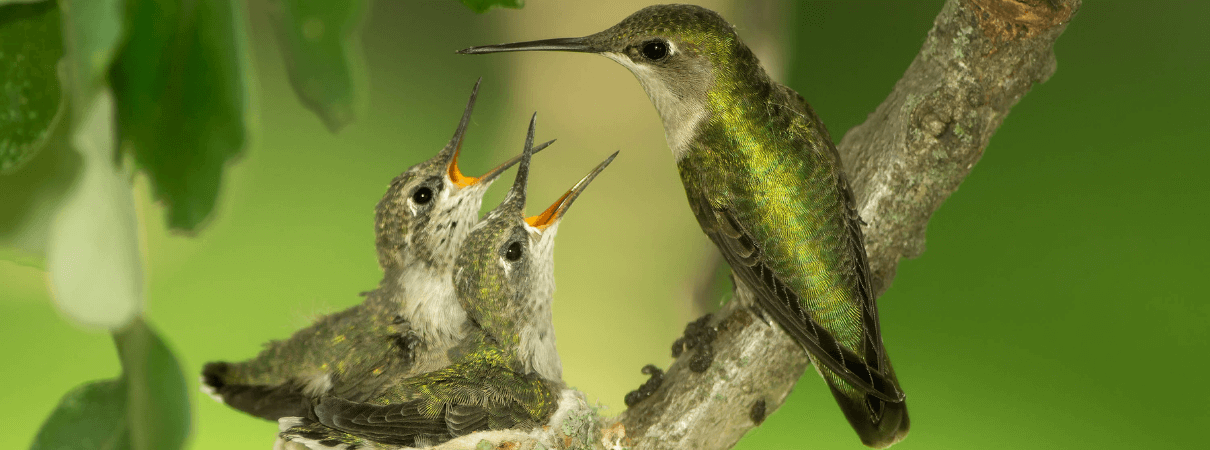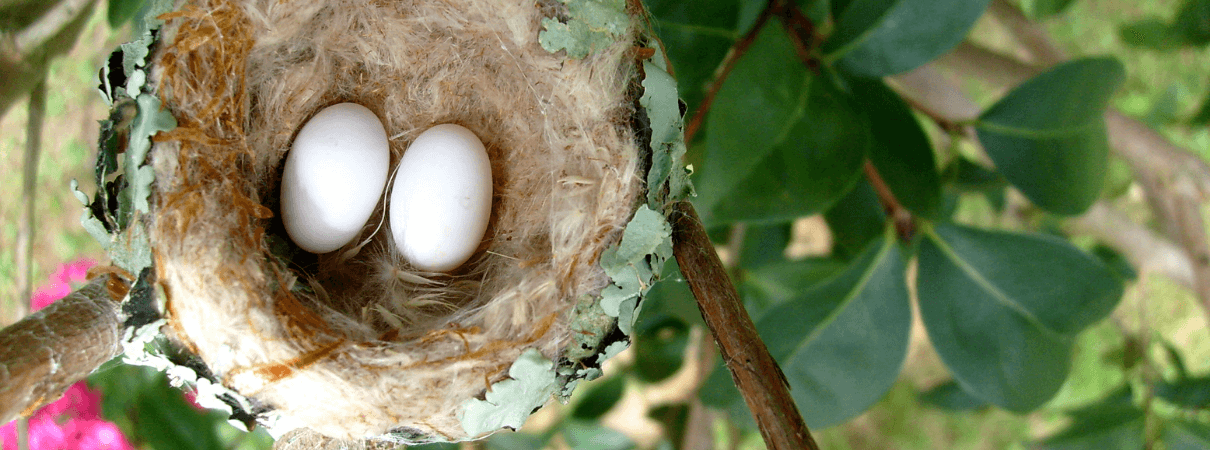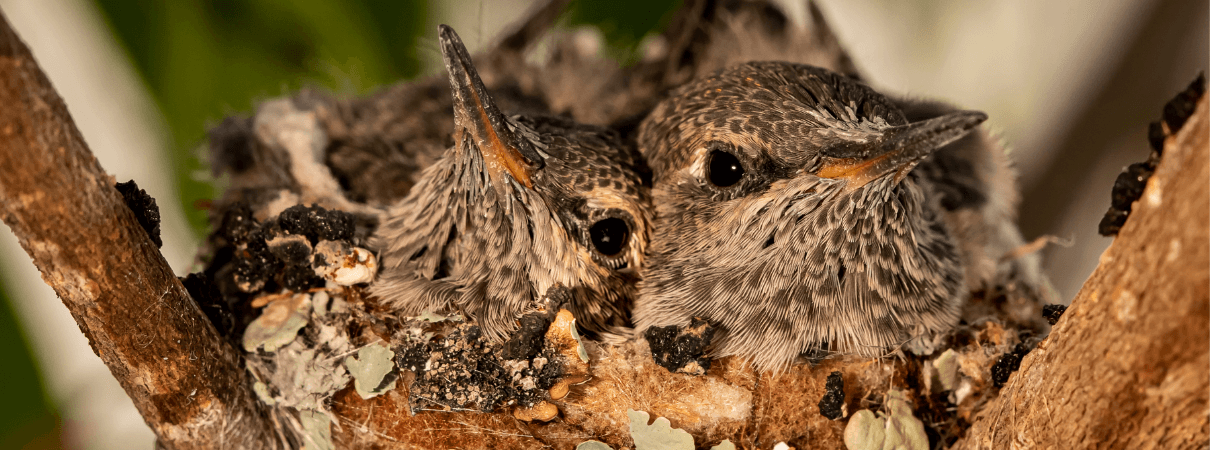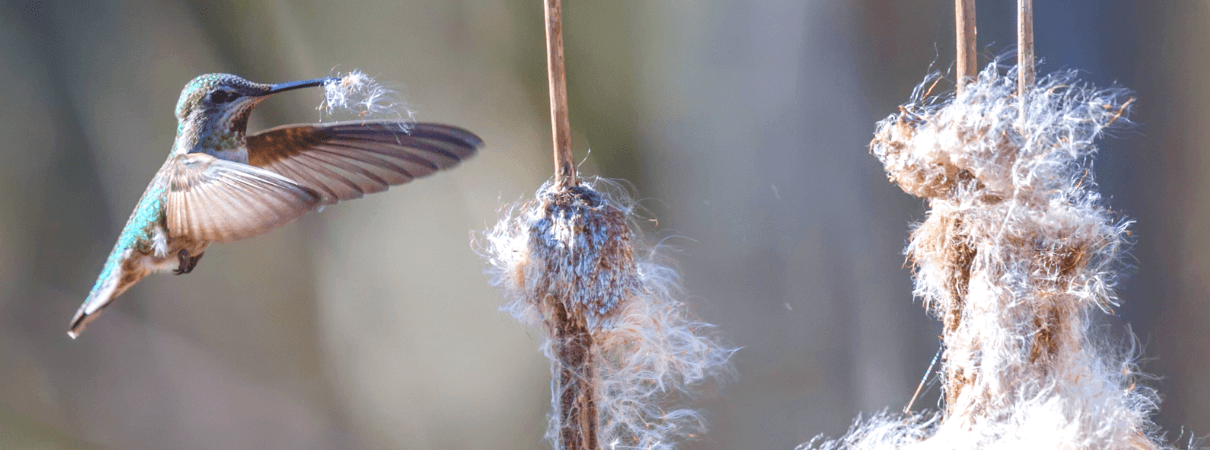Hummingbird Nests 101: A Beginner's Guide
Each spring, hummingbirds return to our gardens, farms, and parks, bringing their sparkle and activity. Birders and non-birders alike are excited to see these birds return. The hummingbird species we see vary depending on location, but these colorful birds brighten up any backyard with their beauty. Their majesty is not without mystery, though — especially when it comes to their nesting habits. Hummingbirds are masters at camouflaging their nests, making them almost impossible to spot, even when you are looking.
To shed some light on how hummingbirds breed, we've put together a beginner's guide. So, if you've ever wondered about the size of hummingbird nests, what time of year these tiny birds build these natural structures, and what to look for, read on!
Where do hummingbirds nest?
Hummingbirds can be picky about where they nest. While some species like the Ruby-throated Hummingbird have adapted to urbanization, sometimes even nesting on wires, plant hangers, and other human-made items, most prefer the cover of deciduous trees growing near water. Tree foliage provides shelter for the parents and their chicks, while the water helps to keep the area cool. Hummingbirds also need to live near food sources, including nectar-rich flowering plants — another reason why sites near water are important for hummingbirds in dry regions.
Due to the small size of hummingbird nests, you're not likely to find one in the crook of a large branch. Instead, hummingbirds tend to "set up shop" on thinner branches roughly one foot from tree trunks, often at a fork.

Female Ruby-throated Hummingbird and chicks. Photo by Agnieszka Bacal/Shutterstock
How can you attract hummingbirds to nest?
Unlike some other popular backyard birds, hummingbirds do not nest in birdhouses. However, there are a number of good ways to tempt them to your yard. You can maintain or plant native flowering plants, provide reliable water sources, and avoid chemicals that harm birds and other wildlife, including the insects hummingbirds prey upon. Properly maintained feeders can also supplement hummingbirds' natural diets and attract them to your property.
How big is a hummingbird nest?
In general, hummingbird nests only measure a little over one inch in diameter! Their size depends on several factors. Different species, of course, build different nests. In general, larger species build larger ones than smaller species do. Construction materials and location can also affect the shape and size of nests.

Hummingbird nest and eggs. Photo by Wellington Nadalini/Shutterstock
What are hummingbird nests made of?
Hummingbirds like their nests to be soft and flexible. To construct them this way, they use a variety of natural materials. Like most birds, hummingbirds start with twigs and other bits of plants, using leaves for a base. However, hummingbirds will also use moss and lichen to camouflage their nests and to make them softer. The secret to a successful hummingbird nest, however, is spider silk. More about that directly below.
How do hummingbirds build their nests?
Female hummingbirds spend up to seven days building their flexible, bowl-shaped nests. First, they create a base layer. Then, they incorporate spider silk by rolling it over the unfinished structure. The silk, which holds the nest together and anchors it to a foundation, is inserted into nooks and crevices to ensure attachment. Construction requires several hours each day.
WATCH: Hummingbird arrives with spider silk to reinforce her nest. Video by Freebilly Photography/Shutterstock
What does a hummingbird nest look like?
Because it is adorned with compacted green lichen, moss, and spider silk, a hummingbird nest can appear like a small knot of wood. Its shape and coloring work as camouflage to keep hummingbird eggs and chicks safe.
When do hummingbirds nest?
The time of year that hummingbirds nest and lay eggs varies by location. In the southern U.S., hummingbird breeding begins as soon as March. In contrast, the process may not start until July in cooler, northern or montane regions. Some western species, such as the Anna's Hummingbird, may start nesting with the first winter rains in November.

Hummingbird chick. Photo by Damsea/Shutterstock
How do you find a hummingbird nest?
Hummingbird nests are extremely hard to spot. As noted above, they are both well-hidden and camouflaged. The best places to look are on thin, forked branches and in dense shrubs. As mentioned above, these nests often look like tree knots. If you spot an oddly placed knot, you might have gotten lucky!
Carefully observing hummingbird behavior is usually key to finding their nests. Watching from a distance, you might be able to spot a female repeatedly visiting the same site during the process of nest construction. During incubation, females leave their nests only for brief periods to forage. If you are lucky enough to spot a female during this phase of breeding, and luckier still to be able to follow her flight path, she may lead you to her nest.
Can I touch a hummingbird nest?
You should not touch hummingbird nests. In the United States, it is illegal to touch, relocate, or remove an active nest. If you discover one, it is best to observe it from a distance. Binoculars will enable you to view the female or young from afar. This will minimize disturbance and avoid inadvertently tipping off a predator, such as a jay, to the location.

Hummingbird chicks. Photo by F Armstrong Photography/Shutterstock
Do hummingbirds leave their nests at night?
Hummingbirds use the night to sleep. In most cases, they will sleep on or by their nests, but not always.
Do hummingbirds reuse their nests?
No. Because hummingbird nests are flexible and expand as chicks grow, they eventually stretch, losing their shape and becoming unsuitable for new use. This means that every new set of eggs requires a new nest!
What can you do to help hummingbirds?
We all can do our part to protect hummingbirds.
American Bird Conservancy and our Joint Venture partners have improved conservation management on 6.4 million acres of U.S. bird habitat — an area larger than the state of Maryland — over the last ten years. This is a monumental undertaking, requiring the support of many, and you can help by making a gift today.
Policies enacted by Congress and federal agencies, such as the U.S. Fish and Wildlife Service, have a huge impact on America's birds. You can help shape these rules for the better by telling lawmakers to prioritize birds, bird habitat, and bird-friendly measures. To get started, visit ABC's Action Center.
Finally, don't overlook the impact you can have in your yard. Creating and improving habitat for hummingbirds can be easy. Check out our "Hummingbird Paradise" post to learn more. For a complete list of daily activities you can take to help birds, visit our Bird-Friendly Life page.

Anna's Hummingbird. Photo by Feng Yu/Shutterstock
How does American Bird Conservancy help hummingbirds?
ABC works with conservation partners and local communities to ensure the survival of the world's most endangered hummingbirds, as well as many other rare, declining bird species and their habitats.
With partners in Latin America and the Caribbean, we have created 93 reserves spanning more than 1 million acres, where 234 hummingbird species find protection.
Habitat restoration is another hallmark of our work with hummingbirds. To date, ABC has planted more than 6 million trees and shrubs to revitalize key habitats, and we're planning to plant 70,000 more.
ABC also supports field expeditions to search for new, and monitor known, hummingbird populations. These efforts allow us to detect changes in populations and identify new threats or changes in the environment that might affect species and their habitats.
 | Kathryn Stonich teaches English for the Community College of Baltimore County and Bryant & Stratton College online. She is an avid backyard birder and advocate for pigeon and dove rescue. |


















































